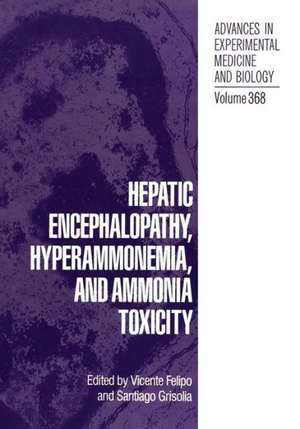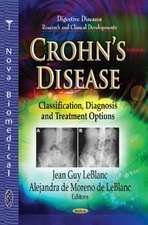Hepatic Encephalopathy, Hyperammonemia, and Ammonia Toxicity: Advances in Experimental Medicine and Biology, cartea 368
Editat de Vicente Felipo, Santiago Grisolíaen Limba Engleză Paperback – 21 oct 2012
Din seria Advances in Experimental Medicine and Biology
- 9%
 Preț: 719.60 lei
Preț: 719.60 lei - 20%
 Preț: 691.93 lei
Preț: 691.93 lei - 5%
 Preț: 717.00 lei
Preț: 717.00 lei - 5%
 Preț: 716.28 lei
Preț: 716.28 lei - 5%
 Preț: 717.20 lei
Preț: 717.20 lei - 15%
 Preț: 640.24 lei
Preț: 640.24 lei - 5%
 Preț: 1113.83 lei
Preț: 1113.83 lei - 5%
 Preț: 715.71 lei
Preț: 715.71 lei - 5%
 Preț: 820.43 lei
Preț: 820.43 lei - 15%
 Preț: 641.38 lei
Preț: 641.38 lei - 5%
 Preț: 716.28 lei
Preț: 716.28 lei - 5%
 Preț: 523.99 lei
Preț: 523.99 lei - 5%
 Preț: 1031.00 lei
Preț: 1031.00 lei - 5%
 Preț: 717.00 lei
Preț: 717.00 lei - 5%
 Preț: 715.35 lei
Preț: 715.35 lei - 20%
 Preț: 1161.71 lei
Preț: 1161.71 lei - 5%
 Preț: 1170.51 lei
Preț: 1170.51 lei - 18%
 Preț: 1119.87 lei
Preț: 1119.87 lei - 5%
 Preț: 1288.48 lei
Preț: 1288.48 lei - 5%
 Preț: 1164.67 lei
Preț: 1164.67 lei - 5%
 Preț: 1101.73 lei
Preț: 1101.73 lei - 18%
 Preț: 1123.67 lei
Preț: 1123.67 lei - 5%
 Preț: 1435.64 lei
Preț: 1435.64 lei - 20%
 Preț: 1044.10 lei
Preț: 1044.10 lei - 18%
 Preț: 946.39 lei
Preț: 946.39 lei - 5%
 Preț: 292.57 lei
Preț: 292.57 lei - 18%
 Preț: 957.62 lei
Preț: 957.62 lei - 18%
 Preț: 1235.76 lei
Preț: 1235.76 lei - 5%
 Preț: 1231.55 lei
Preț: 1231.55 lei - 5%
 Preț: 1292.30 lei
Preț: 1292.30 lei - 5%
 Preț: 1102.10 lei
Preț: 1102.10 lei - 18%
 Preț: 1132.81 lei
Preț: 1132.81 lei - 5%
 Preț: 1165.19 lei
Preț: 1165.19 lei - 5%
 Preț: 1418.48 lei
Preț: 1418.48 lei - 5%
 Preț: 1305.63 lei
Preț: 1305.63 lei - 18%
 Preț: 1417.72 lei
Preț: 1417.72 lei - 18%
 Preț: 1412.99 lei
Preț: 1412.99 lei - 24%
 Preț: 806.16 lei
Preț: 806.16 lei - 18%
 Preț: 1243.29 lei
Preț: 1243.29 lei - 5%
 Preț: 1429.44 lei
Preț: 1429.44 lei - 5%
 Preț: 1618.70 lei
Preț: 1618.70 lei - 5%
 Preț: 1305.12 lei
Preț: 1305.12 lei - 18%
 Preț: 1124.92 lei
Preț: 1124.92 lei - 5%
 Preț: 1097.54 lei
Preț: 1097.54 lei - 15%
 Preț: 649.87 lei
Preț: 649.87 lei - 5%
 Preț: 1097.54 lei
Preț: 1097.54 lei - 18%
 Preț: 945.79 lei
Preț: 945.79 lei - 5%
 Preț: 1123.16 lei
Preț: 1123.16 lei
Preț: 368.19 lei
Preț vechi: 387.58 lei
-5% Nou
Puncte Express: 552
Preț estimativ în valută:
70.45€ • 73.56$ • 58.18£
70.45€ • 73.56$ • 58.18£
Carte tipărită la comandă
Livrare economică 15-29 aprilie
Preluare comenzi: 021 569.72.76
Specificații
ISBN-13: 9781461358206
ISBN-10: 1461358205
Pagini: 228
Ilustrații: VIII, 219 p.
Dimensiuni: 178 x 254 x 12 mm
Greutate: 0.4 kg
Ediția:1994
Editura: Springer Us
Colecția Springer
Seria Advances in Experimental Medicine and Biology
Locul publicării:New York, NY, United States
ISBN-10: 1461358205
Pagini: 228
Ilustrații: VIII, 219 p.
Dimensiuni: 178 x 254 x 12 mm
Greutate: 0.4 kg
Ediția:1994
Editura: Springer Us
Colecția Springer
Seria Advances in Experimental Medicine and Biology
Locul publicării:New York, NY, United States
Public țintă
ResearchCuprins
Animal Models of Hepatic Encephalopathy and Hyperammonemia.- Brain Metabolism in Encephalopathy Caused by Hyperammonemia.- In Vivo Brain Magnetic Resonance Imaging (MRI) and Magnetic Resonance Spectroscopy (MRS) in Hepatic Encephalopathy.- Role of the Cellular Hydration State for Cellular Function: Physiological and Pathophysiological Aspects.- Astrocyte-Neuron Interactions in Hyperammonemia and Hepatic Encephalopathy.- Spinal Seizures in Ammonia Intoxication.- Molecular Mechanism of Acute Ammonia Toxicity and of its Prevention by L-Carnitine.- Portal-Systemic Encephalopathy: a Disorder of Multiple Neurotransmitter Systems.- The GABA Hypothesis: State of the Art.- Neuropharmacologic Modulation of Hepatic Encephalopathy: Experimental and Clinical Data.- S-Adenosyl-L-Methionine Synthetase and Methionine Metabolism Deficiencies in Cirrhosis.- Diagnosis and Therapy of Hepatic Encephalopathy.- Neomycin Reduces the Intestinal Production of Ammonia from Glutamine.- N-Acetylglutamate Synthetase (NAGS) Deficiency.- Ornithine Transcarbamylase Deficiency: A Model for Gene Therapy.- Retroviral Gene Transfer for LDL Receptor Deficiency into Primary Hepatocytes.- The Carnitine System: Recent Aspects.- Use of Hepatocyte Cultures for Liver Support Bioreactors.- Hepatitis C Viral infection after Orthotopic Liver Transplantation.- Exercise-Induced Hyperammonemia: Skeletal Muscle Ammonia Metabolism and the Peripheral and Central Effects.- Possible Role of Ammonia in the Brain in Dementia of Alzheimer Type.- Contributors.










